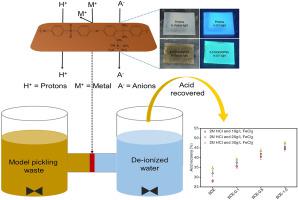当前位置:
X-MOL 学术
›
J. Membr. Sci.
›
论文详情
Our official English website, www.x-mol.net, welcomes your
feedback! (Note: you will need to create a separate account there.)
Polysulfone/graphene quantum dots composite anion exchange membrane for acid recovery by diffusion dialysis
Journal of Membrane Science ( IF 8.4 ) Pub Date : 2020-10-01 , DOI: 10.1016/j.memsci.2020.118331 Vikrant Yadav , Savan K. Raj , Nehal H. Rathod , Vaibhav Kulshrestha
Journal of Membrane Science ( IF 8.4 ) Pub Date : 2020-10-01 , DOI: 10.1016/j.memsci.2020.118331 Vikrant Yadav , Savan K. Raj , Nehal H. Rathod , Vaibhav Kulshrestha

|
Abstract The advancement in membrane-based separation technologies offers advantages over traditional ways. Recovery of acid from acidic waste stream is an important issue to be solved by greener route. Diffusion dialysis using anion exchange membranes (AEMs) is an energy-intensive and environment friendly process to be taken forward. Herein, we report the eco-friendly route for chloromethylation of polysulfone using chloromethyl ethyl ether (CMEE). Effect of chloromethyl ethyl ether concentration, reaction temperature, and reaction time are investigated to get maximum tethered chloromethyl group and high yield of product. Series of chloromethylated polysulfone membranes are prepared with different concentrations of graphene quantum dots (GQDs) followed by quaternization using trimethylamine. The prepared membranes are characterized by their water content, transport properties, and stabilities. Composite membranes show enhanced water uptake, ion exchange capacity, and mechanical stability compared to that of pristine membrane. Interestingly, to address the environmental impact of acids present in industrial waste, AEMs are employed for acid recovery from model waste at higher concentrations of acid and salt using diffusion dialysis. For prepared membranes, 35.5–47.5% acid recovery has been achieved in presence of metal ions. SCE-1.0 (1.0 wt % GQD/ QPSU) membrane shows the highest acid recovery (47.5%) among the membranes. Composite membranes suggest their potential utility in acidic effluent treatment via diffusion dialysis.
中文翻译:

聚砜/石墨烯量子点复合阴离子交换膜用于扩散渗析回收酸
摘要 基于膜的分离技术的进步提供了优于传统方法的优势。从酸性废物流中回收酸是通过绿色途径解决的一个重要问题。使用阴离子交换膜 (AEM) 的扩散透析是一个需要推进的能源密集型和环境友好的过程。在此,我们报告了使用氯甲基乙基醚 (CMEE) 对聚砜进行氯甲基化的环保路线。考察了氯甲基乙醚浓度、反应温度和反应时间的影响,以获得最大的氯甲基系链和高产率。用不同浓度的石墨烯量子点 (GQD) 制备一系列氯甲基化聚砜膜,然后使用三甲胺进行季铵化。制备的膜的特征在于它们的含水量、传输特性和稳定性。与原始膜相比,复合膜显示出增强的吸水率、离子交换能力和机械稳定性。有趣的是,为了解决工业废物中存在的酸对环境的影响,AEM 被用于使用扩散透析从更高浓度的酸和盐的模型废物中回收酸。对于制备的膜,在金属离子存在下已实现 35.5-47.5% 的酸回收率。SCE-1.0 (1.0 wt % GQD/ QPSU) 膜显示出最高的酸回收率 (47.5%)。复合膜表明它们在通过扩散渗析处理酸性废水中的潜在用途。离子交换容量和机械稳定性与原始膜相比。有趣的是,为了解决工业废物中存在的酸对环境的影响,AEM 被用于使用扩散透析从更高浓度的酸和盐的模型废物中回收酸。对于制备的膜,在金属离子存在下已实现 35.5-47.5% 的酸回收率。SCE-1.0 (1.0 wt % GQD/ QPSU) 膜显示出最高的酸回收率 (47.5%)。复合膜表明它们在通过扩散渗析处理酸性废水中的潜在用途。离子交换容量和机械稳定性与原始膜相比。有趣的是,为了解决工业废物中存在的酸对环境的影响,AEM 被用于使用扩散透析从更高浓度的酸和盐的模型废物中回收酸。对于制备的膜,在金属离子存在下已实现 35.5-47.5% 的酸回收率。SCE-1.0 (1.0 wt % GQD/ QPSU) 膜显示出最高的酸回收率 (47.5%)。复合膜表明它们在通过扩散渗析处理酸性废水中的潜在用途。AEM 用于使用扩散透析从更高浓度的酸和盐的模型废物中回收酸。对于制备的膜,在金属离子存在下已实现 35.5-47.5% 的酸回收率。SCE-1.0 (1.0 wt % GQD/ QPSU) 膜显示出最高的酸回收率 (47.5%)。复合膜表明它们在通过扩散渗析处理酸性废水中的潜在用途。AEM 用于使用扩散透析从更高浓度的酸和盐的模型废物中回收酸。对于制备的膜,在金属离子存在下已实现 35.5-47.5% 的酸回收率。SCE-1.0 (1.0 wt % GQD/ QPSU) 膜显示出最高的酸回收率 (47.5%)。复合膜表明它们在通过扩散渗析处理酸性废水中的潜在用途。
更新日期:2020-10-01
中文翻译:

聚砜/石墨烯量子点复合阴离子交换膜用于扩散渗析回收酸
摘要 基于膜的分离技术的进步提供了优于传统方法的优势。从酸性废物流中回收酸是通过绿色途径解决的一个重要问题。使用阴离子交换膜 (AEM) 的扩散透析是一个需要推进的能源密集型和环境友好的过程。在此,我们报告了使用氯甲基乙基醚 (CMEE) 对聚砜进行氯甲基化的环保路线。考察了氯甲基乙醚浓度、反应温度和反应时间的影响,以获得最大的氯甲基系链和高产率。用不同浓度的石墨烯量子点 (GQD) 制备一系列氯甲基化聚砜膜,然后使用三甲胺进行季铵化。制备的膜的特征在于它们的含水量、传输特性和稳定性。与原始膜相比,复合膜显示出增强的吸水率、离子交换能力和机械稳定性。有趣的是,为了解决工业废物中存在的酸对环境的影响,AEM 被用于使用扩散透析从更高浓度的酸和盐的模型废物中回收酸。对于制备的膜,在金属离子存在下已实现 35.5-47.5% 的酸回收率。SCE-1.0 (1.0 wt % GQD/ QPSU) 膜显示出最高的酸回收率 (47.5%)。复合膜表明它们在通过扩散渗析处理酸性废水中的潜在用途。离子交换容量和机械稳定性与原始膜相比。有趣的是,为了解决工业废物中存在的酸对环境的影响,AEM 被用于使用扩散透析从更高浓度的酸和盐的模型废物中回收酸。对于制备的膜,在金属离子存在下已实现 35.5-47.5% 的酸回收率。SCE-1.0 (1.0 wt % GQD/ QPSU) 膜显示出最高的酸回收率 (47.5%)。复合膜表明它们在通过扩散渗析处理酸性废水中的潜在用途。离子交换容量和机械稳定性与原始膜相比。有趣的是,为了解决工业废物中存在的酸对环境的影响,AEM 被用于使用扩散透析从更高浓度的酸和盐的模型废物中回收酸。对于制备的膜,在金属离子存在下已实现 35.5-47.5% 的酸回收率。SCE-1.0 (1.0 wt % GQD/ QPSU) 膜显示出最高的酸回收率 (47.5%)。复合膜表明它们在通过扩散渗析处理酸性废水中的潜在用途。AEM 用于使用扩散透析从更高浓度的酸和盐的模型废物中回收酸。对于制备的膜,在金属离子存在下已实现 35.5-47.5% 的酸回收率。SCE-1.0 (1.0 wt % GQD/ QPSU) 膜显示出最高的酸回收率 (47.5%)。复合膜表明它们在通过扩散渗析处理酸性废水中的潜在用途。AEM 用于使用扩散透析从更高浓度的酸和盐的模型废物中回收酸。对于制备的膜,在金属离子存在下已实现 35.5-47.5% 的酸回收率。SCE-1.0 (1.0 wt % GQD/ QPSU) 膜显示出最高的酸回收率 (47.5%)。复合膜表明它们在通过扩散渗析处理酸性废水中的潜在用途。











































 京公网安备 11010802027423号
京公网安备 11010802027423号